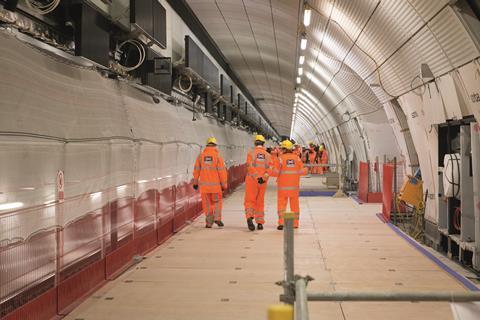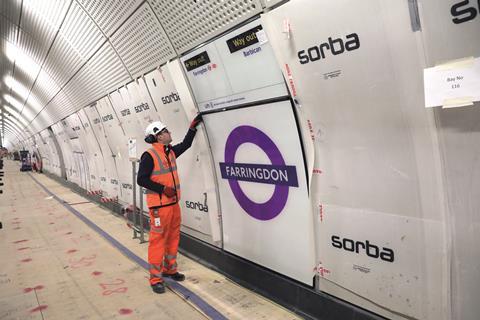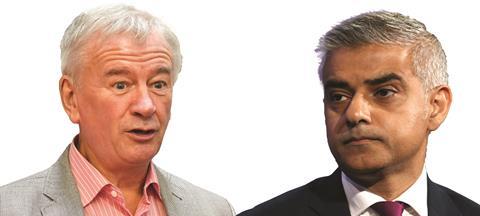Already a year behind schedule and with no end in sight, Crossrail is burning £30m a week in cash as it struggles to reach completion – but as yet, no one can say when that might be. Why is the trans-London line causing such pain?

Originally planned to open just before last Christmas, London’s Crossrail £15bn megaproject is now running about £2bn over budget and more than a year late. Oh, and by the by, the man running it – Mark Wild, its third chief executive in the last year – says staff morale has fallen “off the cliff” and he doesn’t know when it’ll be finished.
When Crossrail announced it would miss its December opening date, blame for the delays was put principally on the complex signalling systems needed to ensure the safe running of the new trains. However, newly released documents and public testimony by current and former executives paint a picture that is altogether more damning for UK construction – of half-built stations, no agreed completion dates and productivity through the floor.
Given the sensitivity of the project, and the fact so many firms are on Crossrail’s payroll, it is hard to find people involved in the scheme who are willing to discuss these problems in public. However, Building has spoken to a number anonymously, including a senior source on the project itself. So, what light has this shed on what really happened on Crossrail, and what does it all mean for UK construction?
Also read: Crossrail - still waiting at the platform
Also read: Crossrail - how the delay unfolded
Civils strife
Since the costly delays were revealed last year, much of the focus has been on who said exactly what to whom, and when – with former chair Sir Terry Morgan and mayor Sadiq Khan descending into an unedifying spat over whether the mayor knew of the delay before August 2018 (see Morgan vs Khan: who said what). But many think this debate is missing the bigger issue of what actually went wrong – and why it seemingly took managers so long to recognise it. Stan Hornagold, project manager and former programme director on the London Underground public-private partnership, says: “Whether the mayor was told in July or August is neither here nor there. It’s ridiculous. Either date is about a year too late.”
The stations are the big problem. I can’t see how this can be delivered in calendar year 2019, and I don’t know when it will be after that
Mark Wild, Crossrail
Initially, the main civil engineering works on Crossrail, begun in 2010, appear to have gone well. However, as the complex M&E equipment began to be installed problems were encountered, such as at Paddington station, where equipment had to be taken out and replaced. As previously reported by Building back in February 2017, construction union Unite branded Crossrail the “hokey cokey line” because of equipment going in only to be taken out. Bernard McAuley, national officer for Unite, described the project as “in meltdown” and productivity as “in pieces” as early as January 2017. But Crossrail maintained the official line that the project as a whole was on time and on budget.
A senior project source told Building last week: “A lot of the work on Crossrail has been absolutely brilliant. But because it was very successful in the early stages, a myth built up. I think it was decided that this reputation was absolutely crucial, meaning the on-time, on-budget mantra was carried on long beyond when it should have done.”
From testimony given since the announcement of the delay, and documents released by Transport for London under pressure from the London Assembly, it is now possible to see that these civils delays, combined with delays in delivering the trains themselves, resulted in the signalling installation, integration and testing programme being severely squeezed to keep to the opening date.
A letter from Juergen Maier, chief executive of signalling contractor Siemens, to Transport for London’s commissioner Mike Brown last February, made clear that problems besetting “civils and energisation contractors” had delayed the installation of the signalling system by a year. Meanwhile an 18-month delay to the trains meant, he said, “the available testing window has reduced from 18 to five months”.
Moreover, Maier set out his fears of “completely missing” the December opening date, and said that the time had come for “complete openness” – a call seemingly not heeded for another six months.
Maier’s letter is corroborated by the testimony of ex-chair Morgan, who says work on the Paddington and Bond Street stations was the “most challenging”. The squeezed testing timetable meant taking civils contractors off the project to allow trains to run through the tunnels – with a programme of five days of construction and two of testing brought in. But with much construction work still to be done, and little success on the testing side, Morgan said this attempt simply “compromised the construction work as a consequence”.

Warning signs
The senior project source says: “The critical thing to understand is that the signalling systems and testing problems and civils delays are totally interrelated. Because of the civils delays, the decision was taken to compress the testing and installation of the signals at the end of the programme. But the signalling installation isn’t possible when you’re doing dynamic train testing.”
The result, the source says, was that: “The warning signs were there 18 months ago. And actually most people on the ground knew that the opening date wasn’t realistic. At the latest the dynamic train testing should have begun in early 2018. When it didn’t, it should have been pretty clear.”
Amid the clear signs of problems, the performance of US consultant Jacobs in its role as project representative (known as the P Rep) – supposedly the eyes and ears of Crossrail’s joint sponsors, Transport for London and the Department for Transport, on the project – has been sharply scrutinised. In May, Jacobs reported back to the joint sponsor board that the project was under pressure and up to £400m in additional funding was needed – but did not conclude the delivery date was in jeopardy.
David Hughes, strategy director at Transport for London (TfL) and a member of the Crossrail sponsor board, told the TfL board in January that auditor KPMG was “right to identify shortcomings in the [project representative] performance in this period”, while Crossrail chair Tony Meggs told the same meeting he was “disappointed” with the P Rep’s reports, which were “more reporting than challenging”.
The evidence suggests it wasn’t only Jacobs that wasn’t joining up the dots. KPMG’s report into the problems, commissioned when the delay was announced last summer, shows that as late as June last year, Crossrail’s own report to the joint sponsor board rated the December opening date as “green” – not at risk – despite the fact it flagged 25 individual “amber” and “red” warnings on specific parts of the project, in areas including dynamic testing, trial running and infrastructure provision. TfL’s Hughes added: “In defence of the P Rep I think they were reliant on the information and reporting they were getting, which as we now know, was telling a very misleading picture.”
Jacobs declined to comment.
The result, KPMG found, of this failure to recognise the problems earlier, was that Crossrail started effectively winding down parts of the organisation over the summer ready for completion – action that made it harder to turn around the performance when the delay was ultimately admitted.
Why the dots weren’t joined is, so far, simply a matter for speculation. Hornagold says: “You can be sure that the answers will have been in the project team all along. There can be a variety of motives, if senior management didn’t know, that those below them were not telling them. Often, people just like a quiet life.”
One senior industry figure involved in the 2012 Olympic infrastructure build says: “It seems like people were hearing what they wanted to hear, and taking an over-optimistic view that they could pull things back. Managers have to create an environment where people are willing to get all the problems out on the table.”

Morgan vs Khan: who said what
Mayor of London Sadiq Khan has insisted he had no knowledge the delivery date would be missed until being informed by the Crossrail board on 30 August – a day before it was made public. However, Crossrail’s then chair, Sir Terry Morgan, insists he briefed the mayor about the need for a delay in a meeting one month earlier, on 26 July.
Morgan’s assertion appears to be supported by slides from his presentation at that meeting, which has since been released by the mayor under pressure from the London Assembly. These describe the December opening date as being “at high risk” and outline a series of alternative opening dates from May 2019 to August 2019 – with even the probability of opening in May put at just 10%. The slides also state partial opening is “not feasible”.
However, Khan has since insisted Morgan nevertheless verbally assured him at the July meeting that the December date was still being targeted, tellingthe London Assembly in December that Morgan had “misremembered” events.
In January, Morgan denied this, adding that Transport for London “amended” his weekly reports to the mayor, and scripted his appearance at the 25 July Crossrail board meeting to “take out any reference to the fact that there was going to be a delay in 2018” – accusations TfL has since denied.
Asked if he verbally assured the mayor at the 26 July meeting that the project was on time, Morgan said: “I emphatically state […] there was no suggestion we could deliver this in 2018.”
Half-finished
The scale of this failure to join the dots is only just becoming clear, as it emerges quite how far behind the civils work fell as access time was squeezed to allow for testing. Crossrail’s new chief executive, Wild, told the TfL board in January that currently none of the nine stations in the central section are totally complete, and only at Farringdon and Woolwich have the main contractors got sufficiently close to completion to be able to demobilise their large “marching army” of workers. Achieving what Crossrail calls “substantial demobilisation” on these stations is critical for bringing down the £30m weekly cost of the project identified by KPMG in December.
But Wild says this demobilisation won’t happen on the last of the stations until “June-July-August”, and that only in recent weeks has Crossrail actually tied contractors into agreed delivery dates. “We’ve worked very hard over the past two months to get contractual buy-in from the tier-one contractors. I think for the first time on Crossrail we have the buy-in from contractors contractually to these dates. It still doesn’t mean we’ll achieve them; it means we’ve got alignment, which we’ve never had before.
Corroborating Unite’s 2017 allegation, Wild also admits productivity on the central section stations, for which Crossrail is responsible, has been “low” – having fallen to just 30%-35% of where it should be, while “only half of the installation work is completed at the stations”.
This project will transform people’s journeys in London and it will be amazing when it finishes. People will forget about these problems when it’s open
David Higgins, former chair of HS2 and ODA
Hopes and fears
The hope is, of course, that once Crossrail finally opens, the problems building it will be quickly consigned to history. David Higgins, former chair of HS2 and the man who delivered the London 2012 Olympics as chief executive of the Olympic Delivery Authority, says: “This project will transform people’s journeys in London and it will be amazing when it finishes. People will forget about these problems when it’s open.
“In 2007 a completion date was picked, and these issues reflect the reality that from that far off it is incredibly difficult to land something as complex as this on a pin.” Likewise, former transport minister, TfL board member and mayoral candidate Steve Norris hopes the public will be forgiving on such a complex scheme: “I’m afraid the lesson from major projects almost everywhere in the world is that they overrun.”
Nevertheless, many worry what the impact of all this will be on UK construction’s reputation for delivery when combined with delays to Tottenham Hotspur’s new football stadium and reports of rising costs on HS2. One senior engineering source says: “This might make the politicians nervous – no politician wants to be in the position of announcing a major project delay.”
A separate senior contracting source, referring to a yet-to-be-completed Berlin airport on which construction was originally due to finish in 2012, says: “The public’s consent to invest in big projects is based on the idea they’ll be done professionally. If we end up with a Brandenburg airport-style farce, or if HS2 is suddenly £100bn, then people could start to say this isn’t what they signed up to.”
Many in the industry will hope that, whatever Crossrail’s complexity, its problems can be resolved sooner rather than later.
Also read: Crossrail ‘ignored warnings’ scheme would bust deadline
Also read: Crossrail – still waiting on the platform
Also visit: Building’s Crossrail hub page, with all the latest news and analysis about the project
Crossrail: what happens now?
New Crossrail chair Tony Meggs told the Transport for London board on 30 January that he was developing a whole new plan to deliver the project “from the bottom up”. However, chief executive Mark Wild told the same meeting that Crossrail was still unable to say when the key central section of the scheme will be completed. With Crossrail spending £30m a week, Wild said, major uncertainty remained over the timing of getting both the testing of the trains and the station builds completed. He said testing was taking place four days out of seven and was now proceeding well – but that Crossrail was still engaged in the “simple stuff” in the very early stages. “We don’t exactly know how long dynamic testing will take,” he said.
Even less certain is station completion. Here the first priority, Wild said, was to get stations “substantially” complete in order to be able to stand down the tier-one contractors and their “very, very large marching army”, responsible for the majority of the weekly project cost. The nine station builds were all originally let under NEC target cost contracts, leaving Crossrail liable for the overruns, with contractors only in recent weeks legally tied into fixed completion dates, which run as late as August this year. Wild said he was “deploying the full intensity of focus to get the job completed”.
After the station build, he said, the “very intricate and complex” job of integrating these stations with Crossrail’s systems was needed, each of which would typically require four to five months’ work. Overall, he said, there are “60,000 individual items that need controlling and integrating”. He added: “The stations are the big problem. I can’t see how this can be delivered in calendar year 2019, and I don’t know when it will be delivered after that.”



























1 Readers' comment